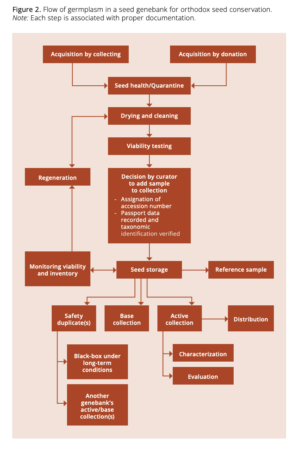- There’s a piece in The Guardian on how Spanish wine makers are fighting climate change by going back to old grape varieties like estaladiña.
- Maybe the same will happen with bananas, and its wild relatives could help? If so, it’s good we have this nifty catalogue.
- A pan-African tree seed platform is in the making, thanks to CIFOR-ICRAF and IKI funding. Where’s the catalogue?
- Here’s a video from the University of Wisconsin-Madison on A New Way of Teaching Ancient Foodways.
- And a video from USDA on their work on genotyping coffee collections.
- Meanwhile, Barbados is still thinking about building a genebank.
- The Genetic Literacy Project does some myth-busting (or tries to): have modern varieties decreased the diversity within crops, are contemporary plant varieties really not suitable for low-input farming, and is improving agricultural practices enough without plant breeding? Take a wild guess.
- Yam researchers in Benin have their own take on improving agricultural practices.
- More climate funding should go to food system transformation, says the Global Alliance for the Future of Food in a report. Those Spanish winemakers — and everyone else above — would probably agree.
Brainfood: Cryo at CIP, Cryo everywhere, Citrus conservation, Seed storage, Pollen double
- The world’s largest potato cryobank at the International Potato Center (CIP) – Status quo, protocol improvement through large-scale experiments and long-term viability monitoring. It’s been a long road, but they’re almost there…
- Overcoming Challenges for Shoot Tip Cryopreservation of Root and Tuber Crops. …but there’s a bit further to go for other roots and tubers….
- Conserving Citrus Diversity: From Vavilov’s Early Explorations to Genebanks around the World. …and citrus.
- Seed Longevity — The Evolution of Knowledge and a Conceptual Framework. The road goes on forever.
- The 3D Pollen Project: An open repository of three-dimensional data for outreach, education and research. The road has to begin somewhere.
- Pollen Cryobanking—Implications in Genetic Conservation and Plant Breeding. And we’re off…
Nibbles: Green seeds, Yam bean, Aussie wild tomato, Einkorn trial, US sorghum, Ethiopian forages tricot, Cuisine diversity, Apple catalogue, Hittite crash, Black Death
- Let’s say we wanted to transition to a more local and low-input production system in Europe. What seeds would we need and where would we get them from? The Greens/EFA in the European Parliament have some ideas.
- IITA is pushing the yam bean in Nigeria. Europe next?
- More on that new Australian wild tomato from a couple of years back. With audio goodness.
- The largest ever einkorn variety comparison trial makes the German news. Well, makes a press release anyway. Yam bean next?
- Another continent, another ancient grain: sorghum in the US. Yam bean next?
- The Ethiopia Grass project aims to improve livestock production, food crop yields AND soil quality. The trifecta!
- Nice infographics displaying dodgy data on the most common ingredients in different cuisines. Yam bean and einkorn nowhere to be seen.
- Cool community-created online catalogue of British apples. Looking forward to the yam bean one.
- It was drought that did for the Hittites, not lack of yam beans. Sea Peoples unavailable for comment.
- It was Yersinia pestis from Issyk-Kul that nearly did for Europe in the Middle Ages. Yes, you can study the genetic diversity of ancient deadly bugs and well as that of crops like yam bean and einkorn.
From theory to practice in genebank operations
Do you find the Genebank Standards for Plant Genetic Resources for Food and Agriculture a little, shall we say, hard to digest? Not to worry, there are now handy practical guides for the application of the Genebank Standards. Which will hopefully make them a little easier to use.
The action steps of the genebank workflow are presented in a sequential manner and provide guidance on the complex steps and decisions required when operating a seed genebank, field genebank, or an in vitro genebank. The accompanying summary charts for the respective action steps underscore the intended use of each practical guide as a handbook for routine genebank operations.
Let us know in the comments what you think.

The Seed Information Database is back!
Readers may remember a post from about a year ago announcing with sadness the imminent demise of Kew’s Seed Information Database (SID).
Well, cheer up. It seems SID is back.
The Seed Information Database (SID) is now hosted by the Society for Ecological Restoration (SER) in collaboration with the Royal Botanic Gardens Kew (RBGK). SID is a compilation of seed biological trait data, with records derived from measurements and observations on seed collections held in Royal Botanic Garden Kew’s Millennium Seed Bank and from other unpublished and published sources, through donation or abstraction.
Good news for genebanks everywhere.